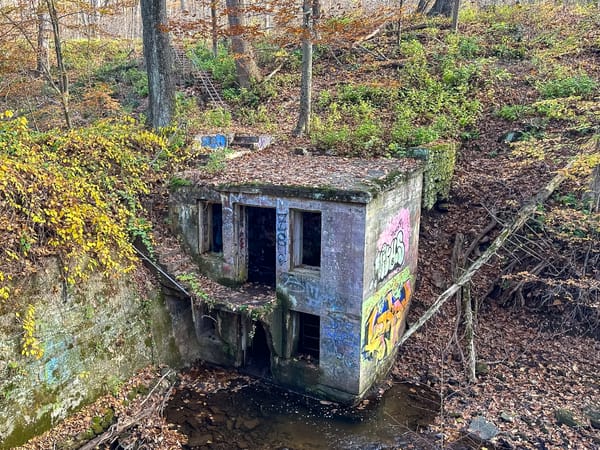Battery Bankhead (Newport, RI)
Battery Bankhead is a long-forgotten relic of America’s coastal defense network. It stands on the grounds of Fort Adams State Park in Newport, Rhode Island.

Perched on the historic grounds of Fort Adams State Park in Newport, Rhode Island, Battery Bankhead is a long-forgotten relic of America’s coastal defense network. Built during the Endicott Period — a nationwide effort to modernize U.S. harbor fortifications between 1890 and 1910 — this reinforced concrete battery once helped guard Newport Harbor, one of the East Coast’s most strategic naval gateways.
Today, though fenced off and inaccessible to the public, Battery Bankhead remains a fascinating remnant of Rhode Island’s military past — a silent monument to an era when concrete and steel replaced brick and cannon.
The Construction of Battery Bankhead
Plans for Battery Bankhead were approved as part of the Harbor Defenses of Narragansett Bay, intended to strengthen Newport’s coastal security. Construction began in October 1904 and was completed by 1906, with the U.S. Army Coast Artillery Corps officially taking control on July 31, 1907.
The battery was named in honor of Major General James Bankhead, a distinguished U.S. Army officer who served during the War of 1812, the Seminole Wars, and the Mexican-American War before his death in 1856.
Design and Armament
Battery Bankhead was designed as a two-level, reinforced concrete fortification typical of Endicott-Era engineering. It originally mounted three 6-inch Armstrong guns on Armstrong pedestal mounts, each capable of defending the approaches to Newport Harbor.
The upper level held the gun platforms, while two magazines on the lower level stored powder and shells. Because the battery lacked shell and powder hoists, all ammunition was carried manually — a labor-intensive but common feature in smaller coastal batteries of its time.
Decommissioning and the Transfer to Hawaii
As naval warfare evolved, many Endicott-Period batteries were quickly rendered obsolete. By 1913, less than a decade after it was completed, Battery Bankhead’s future was uncertain. The Army decided the guns would serve better elsewhere, and on September 26, 1913, orders were issued to transfer all three guns and their carriages to Fort Kamehameha in Honolulu, Hawaii.
With its armament removed, Battery Bankhead was decommissioned and left abandoned — never to see active service again. It was one of several Rhode Island batteries to be deactivated before World War I.
What Remains of Battery Bankhead Today
While Fort Adams State Park welcomes thousands of visitors each year, Battery Bankhead remains closed to the public. The structure sits behind a barbed-wire fence, with “No Trespassing” signs marking the perimeter for safety and preservation reasons.
However, the battery can still be viewed from Jackson Court, a nearby roadway offering a partial glimpse of the concrete walls and overgrown embankments. The site is officially listed on the National Register of Historic Places (Reference #70000014) as part of Fort Adams State Park.
Though inaccessible, Battery Bankhead continues to spark interest among military historians and local preservationists — many of whom hope that one day the site might be stabilized and opened for interpretation.
Visiting Information
While the battery itself is closed, you can still see it from a distance and enjoy the broader historical landscape of Fort Adams State Park, which features guided tours, scenic harbor views, and other restored batteries from the same period.
Location Details
- 📍 Address: Jackson Court, Newport, Rhode Island
- 🌐 GPS Coordinates: 41.477111, -71.340250
- 🚗 Parking: None at the site; limited street viewing only
- ⚠️ Access: Not open to the public — best viewed from Jackson Court
If you visit, please respect posted signs and barriers to preserve this historic site.
Why Battery Bankhead Matters
Though small and short-lived, Battery Bankhead embodies the spirit of the Endicott Period, when the U.S. transformed its coastal defenses for a new technological age. Its reinforced concrete, pedestal-mounted guns, and position overlooking Newport Harbor mark a pivotal shift in military strategy — one that bridged the gap between 19th-century masonry forts and 20th-century concrete emplacements.
Even behind a fence, Battery Bankhead tells a story of innovation, impermanence, and Rhode Island’s ongoing connection to the sea.
Quick Facts
- 🕰 Built: 1904 – 1906
- 💰 Cost: N/A
- ⚙️ Armament: Three 6-inch Armstrong guns on pedestal mounts
- ⚡ No hoists: Ammunition moved manually
- 🔄 Transferred: Guns sent to Fort Kamehameha (Honolulu) in 1913
- ⛔ Decommissioned: Before World War I
- 🏛 Listed on: National Register of Historic Places (#70000014)
Final Thoughts
While Battery Bankhead may be off-limits today, its story remains an essential piece of Newport’s layered military history. For anyone exploring Fort Adams State Park, take a moment to look toward Jackson Court — where the quiet ruins of Battery Bankhead still stand guard, a century after their guns fell silent.



